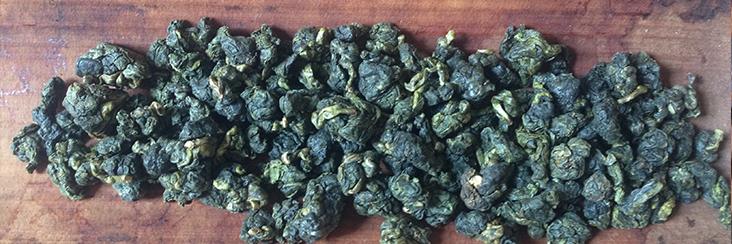
May 11, 2018
How Alishan Oolong Tea Competitions Are Judged

Taiwan is one of the world's premier Oolong Tea producing regions. As such, tea makers in Taiwan are producing some of the best oolong tea in the world.
Taiwan is also the home to tea competitions that makers from all over the island enter their best teas into. First prize at at the largest competitions goes for up to $10,000 USD for 600 grams. One of the most well known tea regions in Taiwan is the Alishan Mountain Range, and Alishan Tea Competitions recognize the best teas from the area.
Each tea competition in Taiwan is judged by slightly different criteria based on the type of tea produced in that region. What makes a good Merlot is different from what makes a good Shiraz, and you would not judge the two by the same criteria —the same goes for premium oolong tea.
Although the general criteria are the same from competition to competition—tea is judged by the dried leaves, aroma, appearance, and of course taste—in this article, we'll examine how an Alishan Oolong Tea competition is judged.
Let's dive in.
Taiwan is also the home to tea competitions that makers from all over the island enter their best teas into. First prize at at the largest competitions goes for up to $10,000 USD for 600 grams. One of the most well known tea regions in Taiwan is the Alishan Mountain Range, and Alishan Tea Competitions recognize the best teas from the area.
Each tea competition in Taiwan is judged by slightly different criteria based on the type of tea produced in that region. What makes a good Merlot is different from what makes a good Shiraz, and you would not judge the two by the same criteria —the same goes for premium oolong tea.
Although the general criteria are the same from competition to competition—tea is judged by the dried leaves, aroma, appearance, and of course taste—in this article, we'll examine how an Alishan Oolong Tea competition is judged.
Let's dive in.
Basic Tea Judging Guidelines
Appearance of Dried Tea Leaves

When judging the quality of competition tea, the first thing assessed is the appearance of the dried tea leaves.
Criteria
Criteria
- Uniform color
- Uniform size
- Uniform shape
- Luster
- Yellow hues
- Pale
- Non-uniform shape and size
Appearance of Brewed Tea Liquor

The next step is judging the appearance of the brewed tea liquor. The criteria used determine the level of proper processing. A light greenish golden color, with a density that refracts light while still being transparent is what the judges are looking for. Lack of transparency or unevenness of color indicates the leaf was not dried properly.
Criteria
Criteria
- Color
- Vibrance
- Transparency
- Uneven color
- Cloudy
Aroma of Brewed Tea Leaves

After cooling down for several minutes, the judges will then note the aroma of the brewed tea leaves. They will examine the quality of aroma that continues to exude from the leaves even after they've been brewed and begin to cool down.
Criteria
Criteria
- Freshness
- Floral
- Fragrant
- Burnt or stale notes
- Too many stems
- Broken leaves
Appearance of Brewed Tea Leaves

Assessing the appearance of the leaves after brewing tells a lot about the nature and quality of the tea leaf. Are the leaves uniform in their coloration and consistency? Is there a noticeable yet subtle coloration of stems and leaf edges indicating the level and consistency of oxidation? A gradation of color is ok but blotchy is not. Judges will hold leaves up to the light to see if the oxidation/dehydration of the leaf is uniform. The brewed leaves should be supple yet substantial.
Criteria
Criteria
- Uniformity
- Uniform gradation from center (green) to red (edges) to show the partial oxidation of an Alishan Oolong.
- Suppleness (no hard or ridged texture)
- Splotchiness
- Spotted
- Too hard
Flavor: Taste of The Brewed Tea

Now for the big ticket item, the flavor. The flavor will confirm or deny the visual assessment. If the flavor is not lacking or deviant from the standard of a fresh, clean, balanced and smooth composition, the tea qualifies and makes it to the next round of judging.
Conclusion
If the tea meets the all the criteria described in this article, it represents that the tea was well-cultivated and processed with skill and care.Having said this, know that competition standards are necessary to have an impartial assessment, but what makes a special tea is also subjective, and we have tasted incredible teas that don't fit the mold. There is a large spectrum of subtle differences that result from growing, harvesting, and processing conditions—many teas of extraordinary quality may not be suitable by competition standards. Differences can also be regional and cultivar based.
We encourage you to assess any given tea by your own experience as much as by these professional guidelines. In the end, tea should be enjoyed and enhance our lives via its health benefits, cultural richness, and infinite variety of character.
In short...if you like it, drink it!
What do you think? Is competition tea better than non? What's your favorite thing about tea? Aroma, appearance, flavor, or just the feeling you get when settling in with a good cup? Post your comments, photos and videos here or share with the community on Facebook or Instagram @ecochateas.
If you liked this post please share. Sharing lets us know you liked it and we should keep writing more like it. Thanks!

